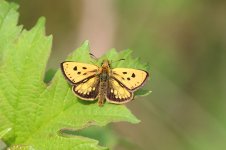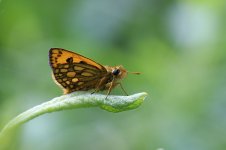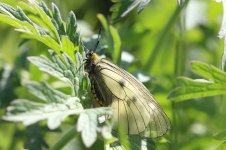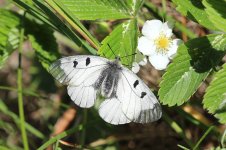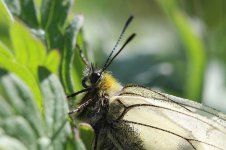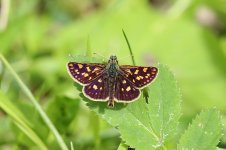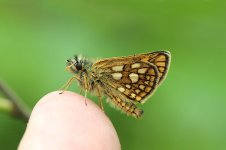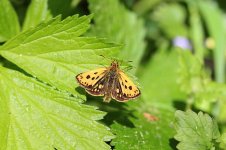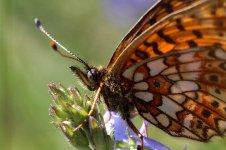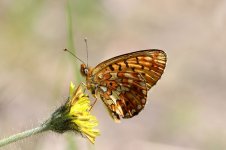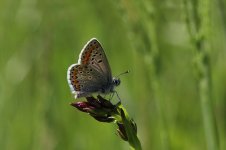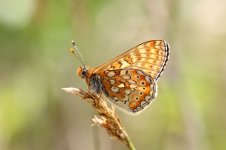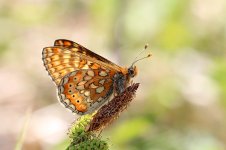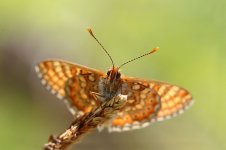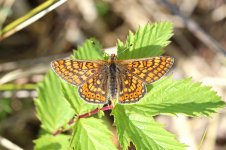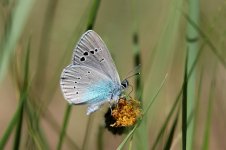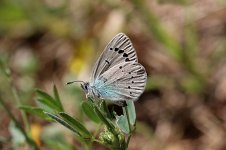27-28 May. Clouds, Chequers and Pearls.
A hundred kilometres north of Vilnius, a roadside verge, 9.30 am, warm and sunny, clouds of butterflies active, clouds of Clouded Apollos! Had been looking for this species for a week and here they were, a synchronised emergence of a whole bunch of them, pristine individuals sailing across the grassy slope, more pumping life into their wings as they entered adulthood. Quite a magical sight indeed, a splendid start to an weekend! Estimated there were at least 45 Clouded Apollos at this single spot, enhanced by a Pale Clouded Yellow and growing numbers of both Sooty Copper and Small Heath. A few kilometres further, I found another four Clouded Apollos drifting along a riverbank, then explored a hillside to find my first Heath Fritillary of the year and five Wall Browns.
Target two, Chequered Skipper. Middle Lithuania, wet deciduous woodland. Located a sunny glade and set out to explore, within a kilometre bumping into two chequers of the 'wrong' sort – Northern Chequered Skippers, bright creamy-yellows on the wings. Fortunately the third chequer along this very same glade was an exquisite pockering of brown and cream, a classic Chequered Skipper. All too brief, I managed not a single photograph before it disappeared! No big problem, checking further glades, I located yet more, this single forest block finally producing a total of three Northern Chequered Skippers and five Chequered Skippers, one of the latter even perching on my finger for a while!
With success on my two main targets, I decided to cut across to a couple of sites in the Kaunas area for the remainder of the day – wispy high cloud quietened things down a tad, but not too much – in sunny spells, I added a whole bunch of species, not only my third dose of Clouded Apollos of the day, but also two more Chequered Skippers, my first Mazarine Blue of the year and my first Little Blue of the year.
Next day, with temperatures soaring to an impressive 28 C, it was the turn of some of my favourite meadows to impress. Meandered around with butterflies rising from all quarters – dozens of Sooty Coppers, a few Small Coppers, at least 15 Queen of Spain Fritillaries, one Weaver's Fritillary, several Pale Clouded Yellows, a couple of Eastern Bath Whites, a minimum of 45 Small Heaths. Best of all however, the pair of pearls – a number of Small Pearl-bordered Fritillaries in the grassland, then the crowning glory, three Pearl-bordered Fritillaries at woodland edge. Not a species I see very often in Lithuania, these were welcome indeed. Also one Swallowtail and a good dozen or so other species.
Rounding off the weekend, I went for a squelch in a raised bog – low and behold, more Pearl-bordered Fritillaries, about eight present this time, plus a wholly rare species, Baltic Grayling. Second time to see this bog specialist within ten days, many were present here, a minimum of 45 in the small area of habitat that I explored. Also a last couple of Green Hairstreaks and one more Swallowtail.
And so ended my weekend - not bad at all, several very localised species under the belt and 33 species noted in all.
BALTIC YEAR LIST
35. Clouded Apollo
36. Little Blue
37. Mazarine Blue
38. Heath Fritillary
39. Pearl-bordered Fritillary
40. Wall Brown
41. Chequered Skipper
.






